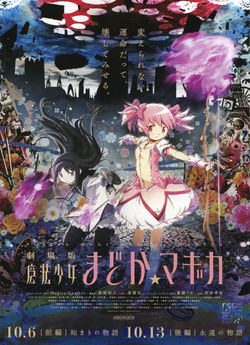Puella Magi Madoka Magica the Movie Part 2: Eternal

"Even the unchangeable destiny will be shattered." – Movie poster.
Puella Magi Madoka Magica the Movie Part 2: Eternal (劇場版 魔法少女まどか☆マギカ[後編]永遠の物語 Gekijouban Mahou Shoujo Madoka Magica [Kōhen]: Eien no Monogatari, lit. Magical Girl Madoka Magica the Movie [Second Part]: The Eternal Story) is the secod movie in the Puella Magi Madoka Magica the Movie series, released on October 13, 2012[1]. Covering the last four episodes of the anime, it serves as a recap to the original anime series and features redone voice acting and animation. It is a sequel to Puella Magi Madoka Magica the Movie Part 1: Beginnings.
The opening theme of the movie is "Luminous" by ClariS and the ending theme of the movie is "Hikari Furu" by Kalafina.
Plot Overview
Madoka Kaname is an eighth-grader who leads a peaceful, fun-filled life as a student, surrounded by her beloved family and best friends. One day, a transfer student named Homura Akemi arrives in Madoka's class. Homura is a dark-haired girl, and soon after meeting Madoka for the first time, she goes on to issue Madoka a strange warning. Madoka also meets Kyubey, a mysterious looking creature who tempts her by saying, "I'll make any of your wishes come true. So make a contract with me and become a Magical Girl!" Madoka feels that there is nothing special about her, so she decides to take up Kyubey's offer so she can help people... Who are the people she meets that will change her destiny, and what is the answer she finds?[2]
Characters
Staff and Cast
See also: Madoka Magica Staff and Cast and the staff listings on the official site (Japanese).
All voice actors return from the anime, reprising their previous roles. Similarly, animation, action, and music directors all return from their roles in Puella Magi Madoka Magica.
Notable differences from the original anime
General
In the movie and each following appearance, Sayaka Miki dons a hair clip in the shape of fortissimo when she is in her Magical Girl form. In music, a fortissimo indicates that the piece should be played very loudly.
Kyoko has more variety of food in each scene she is in. She is seen eating green tea and strawberry pocky in addition to her usual chocolate variety. She is also seen eating a sandwich cookie, a bear pastry, and an orange popsicle.
A new score by Yuki Kajiura was introduced, replacing much of the original music. Additionally, a vocal version of Credens justitiam, Mirai, is used as the ending theme.
Movie specific
Oktavia von Seckendorff's barrier has new runes that read "Desiderantes Affectibus". Summis desiderantes affectibus (Latin: "Desiring with supreme ardor") was a papal bull issued by Pope Innocent VIII on December 5, 1484. The bull was written in response to the request of Dominican Inquisitor Heinrich Kramer for explicit authority to prosecute witchcraft in Germany, after he was refused assistance by the local ecclesiastical authorities. The bull recognized the existence of witches. The bull, which synthesized the spiritual and the secular crimes of witchcraft, is often viewed as opening the door for the witch hunts of the early modern period.
When Kyoko's soul gem explodes, there's a hidden frame of the "and I'm home" picture.
Gallery
See here for animation differences and other visuals.
Posters
-
Japanese poster
Screenshots
-
"LOOK AT ME"
-
The runes read "Desiderantes Affectibus"
-
When Kyoko's soul gem explodes, there's a hidden frame of the and I'm Home picture.
-
Dialogue from earlier episodes.
See Also
- Witch Runes in the movie.
























